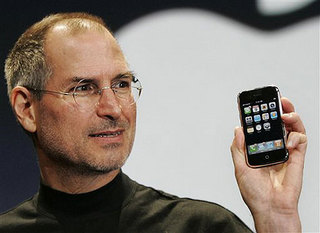
Cell phones — everybody’s got them. Even your 12-year-old nephew whose parents keep tabs on him via the inboard GPS carries a RAZR. So what’s next in this omnipresent device?
In this week’s column, we take a look at what the future of the iPhone, and what we can learn about Apple’s upcoming Macbooks by looking at it, as well as why we can expect to see the Blackberry OS everywhere before long.
WHICH VERSION OF THE iPHONE WILL WE GET?
Since before the iPhone even officially existed, the blogosphere was ripe with speculation that the initial offering would be just the first in a multi-tier line of Apple-made musicphones. Putting out three sizes of iPods has worked pretty well for Apple, so why wouldn’t they do the same with their phones?
Most of the speculation has been based on the presumption that a $500 piece of machinery could not be anything but the top-tier (like the 80-gig iPod), and that subsequent releases would only be cheaper. However, while price will eventually drop on all iPhones, the initial hardware will almost certainly not be the top-end phone, but will likely morph into the “nano” product.
In a short time, Apple has hit a home run with the “nano” brand. And with this first phone, all the characteristics of keeping with whatever associations we have with a “nano” product are already there — it’s thin and it uses flash memory.
Now, lets take it a step further. What if Apple were to spread their “nano” brand beyond the iPod and iPhone world, and into their notebooks? What if the as-of-yet mysterious ultra-thin Macbook or Apple tablet that everybody’s been buzzing about for about a year were actually branded a “Macbook Nano”? And what if it ran on solid state memory?
THE BLACKBERRY OS WILL BE EVERYWHERE
PDA phone fans have a bit of a problem — most of the hottest new handsets are tied to particular operating systems, virtually all of which have serious shortcomings. Windows Mobile freezes worse than an ice box and kills your battery, Palm OS is rare and getting rarer, and Symbian is just alright. But Blackberry OS? It’s nearly perfect, and the reason Blackberr’s have become the default beltmate of businessmen everywhere. It never freezes, works insanely well with email, and sucks an insanely small amount of juice from your battery (unlike Windows Mobile devices, which need to be plugged in by midday, you can take your Blackberry abroad for a week and get by without packing your outlet converter). And that one traditional shortcoming of the OS, a lack of compatibility with third-party software, is now nearly a non-problem, thanks partly to the fact that Google has been porting all of their mobile apps to it.
Today, the one drawback with Blackberry OS is that it is only available on RIM’s own devices. I predict we’ll see an end to this — and soon. As long as RIM can keep from making the same mistakes Palm did when it tried to divide up its kingdom between the software and hardware sides (a decision that ended with some of their hardware waving the white flag to Microsoft), RIM can make a lot of cash by licensing their software to other phone manufacturers.
Of course, they’ll be hesitant to do this — they probably worry that doing so would partially cannibalize sales of their own hardware (why would anybody buy the cow when they can license the milk for free, as they say.) However, this worry is misguided for two reasons.
First: the profit margins on already-developed licensed software could be astronomical. They likely won’t have to put too much cash into research and development in order to make their OS work on other phones, and distributing it would be a breeze. That means that virtually every cent that comes in from the software would be pure profit.
Second: Making their software more widely available would serve as an advertisement for their own phones. If somebody is a Treo addict and never had a Blackberry for a week, and they buy a Blackberry-powered Treo which they grow to love, the chances are pretty great that their next phone will be one by RIM.

Seth Porges writes on future technology and its role in personal electronics for his column, The Futurist. It appears every Thursday and an archive of past columns is available here.